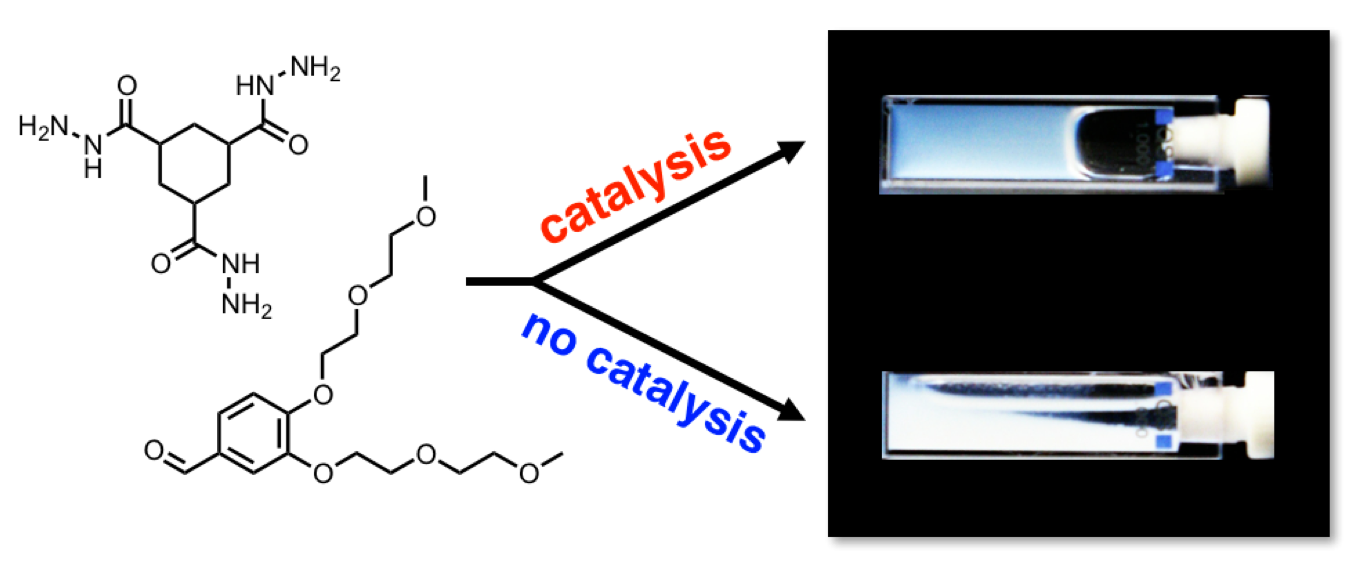Rienk Eelkema Lab
ORGANIC & SOFT MATTER CHEMISTRY & ENGINEERING
Research Topics
Catalysis and Signal Transduction in Soft Materials
Catalysts can change the rate of a reaction forming, breaking or exchanging bonds in a material, thereby changing its properties. By coupling catalytic activity to signal input, we try to create soft materials that can respond to external signals. For this purpose, we have developed several concepts for responsive catalysts.
J. Boekhoven, J. M. Poolman, C. Maity, F. Li, L. van der Mee, C. B. Minkenberg, E. Mendes, J. H. van Esch, R. Eelkema, “Catalytic control over supramolecular gel formation” Nature Chem. 2013, 5, 433.C. Maity, W. E. Hendriksen, J. H. van Esch, R. Eelkema, “Spatial Structuring of a Supramolecular Hydrogel using a Visible-light Triggered Catalyst” Angew. Chem. Int. Ed. 2015, 54, 998.
F. Trausel, C. Maity, J. M. Poolman, D. S. J. Kouwenberg, F. Versluis, J. H. van Esch, and R. Eelkema*; "Chemical signal activation of an organocatalyst enables control over soft material formation" Nature Commun. 2017, 8, 879
M. P. van der Helm, G. Li, M. Hartono, R. Eelkema, "Transient host-guest complexation to control catalytic activity" J. Am. Chem. Soc. 2022, 144, 9465−9471
G. Li, F. Trausel, M. P. van der Helm, B. Klemm, T. G. Brevé, S. A. P. van Rossum, M. Hartono, H. H. P. J. Gerlings, M. Lovrak, J. H. van Esch, and R. Eelkema “Tuneable control over organocatalytic activity through host guest chemistry” Angew. Chem. Int. Ed. 2021, 60, 14022-14029

Chemical Reaction Networks and Out-of-Equilibrium Material Processes
In an attempt to make active materials, we couple the formation and collapse of out-of-equilibrium assembled structures or polymer materials to the consumption of a chemical fuel, allowing the formation of transient structuress, and control over structure formation in time and space. For this purpose, we develop new fuel-driven chemical reaction networks and try to use chemical signals or catalysis to bias their pathways, to make them interact with their surroundings.
J. Boekhoven, W.E. Hendriksen, G. J. M. Koper, R. Eelkema & J. H. van Esch; “Transient Assembly of Active Materials Fueled by a Chemical Reaction” Science 2015, 349, 1075-1079.
B. van Ravensteijn, W. E. Hendriksen, R. Eelkema, J. H. van Esch, W. K. Kegel; “Fuel-mediated transient clustering of colloidal building blocks” J. Am. Chem. Soc. 2017, 139, 9763−9766
M. P. van der Helm, C.-L. Wang, B. Fan, M. Macchione, E. Mendes, and R. Eelkema; "Organocatalytic control over a fuel-driven transient esterification network" Angew. Chem. Int. Ed. 2020, 59, 20604-20611
M. P. van der Helm, T. de Beun, and R. Eelkema; "On the Use of Catalysis to Bias Reaction Pathways in Out-Of-Equilibrium Systems" Chem. Sci. 2021, 12, 4484-4493
R. W. Lewis, B. Klemm, M. Macchione, R. Eelkema; "Signal responsive transient coacervation in complex coacervate core micelles' Chem. Sci. 2022, 13, 4533-4544
B. Klemm, R. W. Lewis, I. Piergentili, R. Eelkema, "Temporally programmed polymer - solvent interactions using a chemical reaction network" Nat. Commun., 2022, 13, 6242
A. Sharko, B. Spitzbarth, T. M. Hermans*, R. Eelkema*; "Redox-controlled shunts in a synthetic chemical reaction cycle" J. Am. Chem. Soc. 2023, 145, 9672-9678
B. Klemm, A. Roshanasan, I. Piergentili, J. H. van Esch, R. Eelkema*; "Naked-eye thiol analyte detection via self-propagating, amplified reaction cycle" J. Am. Chem. Soc. 2023, 145, 21222–21230
Oxidation and radiation responsive materials for controlled release
We develop new soft materials for controlled release of drugs and other bioactive molecules. In collaboration with prof. Antonia Denkova (Radiation Science & Technology, TU Delft) we study approaches for combined radiation and chemotherapy. These concepts require drug delivery materials that can respond to oxidation or radiation triggers.
H. Liu, R. M. de Kruijff, A. C. Laan, F. J. Beekman, E. van den Heuvel, R. Ramakers, R. Eelkema, A. G. Denkova, "Efficient radiolabeling of block copolymer micelles through radiometal salt precipitation for theranostic applications" Adv. Therapeutics 2022, 5, 2200077
I. Piergentili, P. R. Bouwmans, L. Reinalda, R. W. Lewis, B. Klemm, H. Liu, R. M. de Kruijff, A. G. Denkova, R. Eelkema; 'Thioanisole ester based logic gate cascade to control ROS-triggered micellar degradation' Polymer Chem. 2022, 13, 2383 - 2390
H. Liu, A. C. Laan, J. Plomp, S. R. Parnell, Y. Men, R. M. Dalgliesh, R. Eelkema*, A. G. Denkova; "Ionizing radiation induced release from poly(-caprolactone-b-ethylene glycol) micelles" ACS Appl. Polym. Mater. 2021, 3, 968–975
I. Piergentili, M. Cai, B. Klemm, B. Xu, S. Luo*, R. Eelkema*; "Enhancing trigger sensitivity of nanocarriers through organocatalytic oxidant activation" Cell Rep. Phys. Sci. 2023, 4, 101547
Injectable Polymer Hydrogels
We develop polymer hydrogels that can be injected through a syringe needle, for use as drug and vaccine depots in the body. Such materials require dynamic crosslinks, which we develop using dynamic covalent chemistry, or using non-covalent crosslinks. Release profiles and gel dissolution can be engineered by introduction of bond-breaking functionalities that are responsive to specific biomarkers.
B. Fan, K. Zhang, Q. Liu, R. Eelkema; "Self-Healing Injectable Polymer Hydrogel via Dynamic Thiol-Alkynone Double Addition Cross-Links" ACS Macro Lett. 2020, 9, 776-780
R. Eelkema, A. Pich; "Supramolecular or Macromolecular: What's best for Functional Hydrogels with Advanced Properties?" Adv. Mater. 2020, 32, 1906012
B. Wu, R. W. Lewis, G. Li, Y. Gao, B. Fan, B. Klemm, J. Huang, J. Wang, M. A. Cohen Stuart, R. Eelkema; "Chemical Signal Regulated Injectable Coacervate Hydrogels" Chem. Sci. 2023, accepted
B. Fan, D. Torres Garcia, M. Salehi, M. Webber, S. I. van Kasteren*, R. Eelkema*; Dynamic Covalent Dextran Hydrogels as Injectable, Self-adjuvating Peptide Vaccine Depots" ACS Chem. Biol. 2023, 18, 652-659